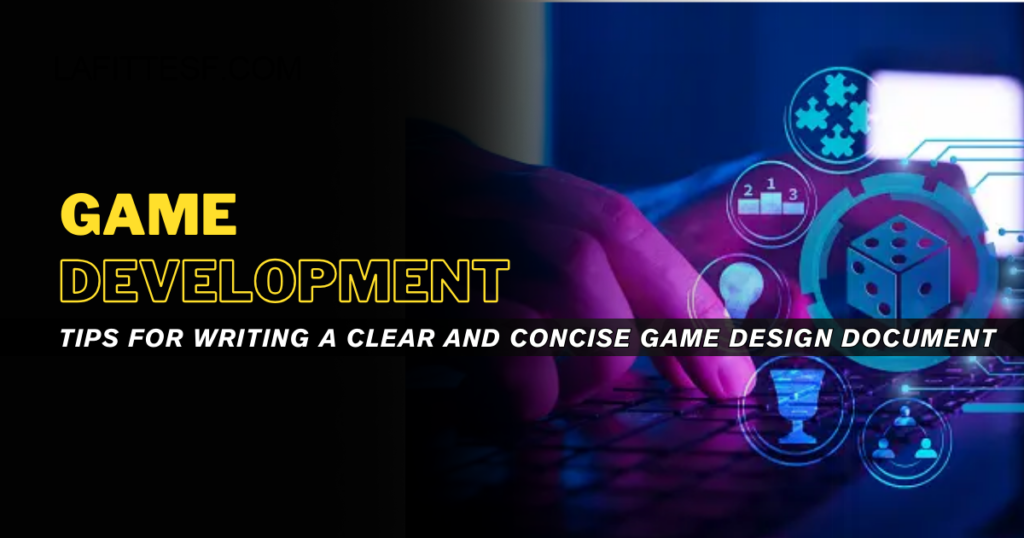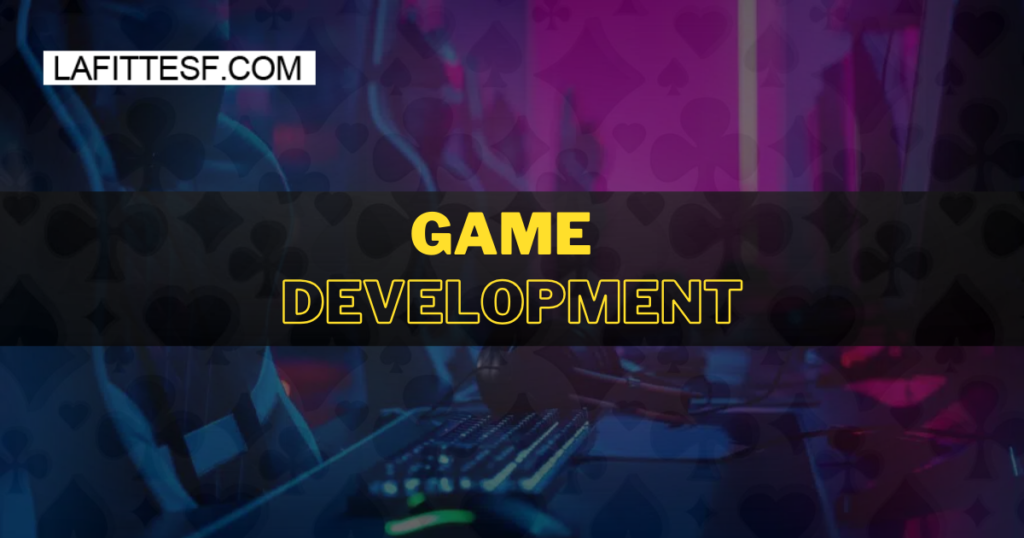Creating a game design document (GDD) is crucial for game developers. It outlines every aspect of the game, from its concept to technical specifications. In this guide, sponsored by Lafittesf, we’ll break down the process of creating games writing an effective GDD into manageable steps.
Table of Contents
Understanding the Purpose of a Game Design Document in Game Development
A GDD serves as a blueprint for the video game development itself, defining video game developers its vision, scope, and roadmap for development. It’s a reference point for the team throughout the project.
Identifying Key Components of a Game Design Document in Game Development
When making a game, a complete Game Design Document (GDD) includes various parts like the game idea, how it plays, characters, levels, how it looks and sounds, technical details, how to make money from it, and when it should be done.
- Concept and Theme
This is like the big idea behind your game. It’s what makes your game unique and interesting.
- Gameplay Mechanics
These are the rules and systems that make your game fun to play. They determine how players interact with your game.
- Characters
Characters are the people, creatures, or things that players control or encounter in your game. They add depth and personality to the experience.
- Levels
Levels are the different parts or stages of your game. Each level presents new challenges or obstacles for players to overcome.
- User Interface and Experience (UI/UX)
The UI is what players see on the screen, like menus and buttons. UX is how easy and enjoyable it is for players to use your game.
- Art Style
The art style sets the visual tone of your game. It includes things like colors, shapes, and overall look and feel.
- Sound Design
Sound effects and music enhance the atmosphere and immersion of your game. They can evoke emotions and make the experience more engaging.
- Technical Specifications
These are the technical details about how your game will be built and run. This includes things like the game engine, programming language, and platform requirements.
- Monetization Strategy
If you’re planning to make money from your game, you’ll need a plan for how to do that. This could include things like in-app purchases, ads, or subscription fees.
- Timeline
The timeline lays out the schedule for developing your game. It includes milestones or checkpoints to track progress along the way.
Step-by-Step Guide to Writing an Effective Game Design Document
- Conduct Research
Study successful games within the realm of game development, focusing on your genre or theme. This allows you to identify trends, mechanics, and themes that connect with players, aiding you in integrating fresh and innovative ideas into your own game. - Define Concept and Mechanics
Here, in the realm of game development, you’ll articulate the core concept and gameplay mechanics of your game. Clearly defining these elements lays the foundation for the entire project. Consider what makes your game unique and engaging. Describe the central theme, the primary objectives players will pursue, and the mechanics that will drive gameplay forward. This step ensures that everyone involved in the project understands the vision and direction of the game. - Character and Story Development
In this phase of game development, you’ll dive into the narrative aspects of your game. Develop detailed character profiles, including their backgrounds, motivations, and personalities. Outline the storyline, including key plot points, conflicts, and resolutions.
Crafting compelling characters and stories adds depth and emotional resonance to your game, enhancing the player experience and immersion in-game development. - Level Design
Designing levels in game development means creating the environments and challenges that players encounter as they progress through the game. It involves deciding on the difficulty level, how it increases, and how players advance. Building a coherent world with various locations is crucial for immersion.
It’s important to consider how players navigate through the game and keep them engaged in each level to make it memorable.
- UI/UX Design
In game development, creating a user-friendly experience is key. Sketching out menu and interface designs helps you understand how everything fits together. Ensure the interface is clear and works well for all players, whether they’re new or experienced in gaming. - Art Style and Visual Direction
Selecting the art style and visual direction is vital in game development. Think about things like art style, colors, and graphics to make your game lively. Providing concept art as a reference helps convey your vision to artists and developers. Keeping consistency and cohesion in art direction improves the overall appeal and atmosphere of your game. - Sound Design
Sound matters in game development for pulling players into the game world. Plan sounds and music to enhance the experience. Different sounds can make the game more enjoyable and set the right atmosphere. Collaborate with music makers and sound experts early in development to ensure they match the visuals and story. - Technical Specifications
Specify technical details such as game engine, programming languages, and platform requirements in game development. Consider factors like performance optimization, scalability, and compatibility with various devices.
Clear technical specifications help developers understand the scope of work and ensure that the game runs smoothly across different platforms.
- Monetization Strategy
For successful game development, plan monetization early. Explore options like in-app purchases, subscriptions, or ads. Balance monetization with player satisfaction to keep players engaged.
- Timeline and Milestones
Finally, in game development, set up a realistic timeline with achievable milestones to guide the development process. Break down the project into manageable tasks and allocate time and resources accordingly.
Regularly review and adjust the timeline as needed to stay on track and meet deadlines. Effective project management ensures that the game progresses smoothly from concept to completion.
Tips for Writing a Clear and Concise Game Design Document

- Use Clear Language and Visuals
In your game development document (GDD), focus on clear language and visuals. Use simple terms that everyone understands and include diagrams or sketches to explain ideas. Visuals help clarify complex concepts and ensure everyone understands. - Organize Information Logically
Structuring your game development document (GDD) logically helps readers understand it better. Use headings, subheadings, and bullet points for a smooth flow between sections.
Group similar information and use clear transitions to move between topics.
Effective organization of your GDD makes it easier for everyone involved in the project to access and understand.
- Be Detailed but Avoid Unnecessary Details
Make sure you give just the right amount of information to explain your ideas well. Include only what’s important for making the game and reaching your goals. Don’t get stuck on tiny details or add too much specific stuff that doesn’t help with the main vision of the game.
Keep your GDD clear and to the point, so it’s easy for everyone to understand and use.
- Update the Document as the Project Progresses
As your game progresses, keep updating your GDD to match. Whenever new ideas come up, or if changes happen, make sure your GDD reflects them. Check and edit your document often to make sure it’s still right for the project.
Keeping your GDD current stops confusion, stops the project from growing too big, and makes sure everyone stays on the same page.
- Involve Key Stakeholders in the Review Process
Get everyone involved in making your GDD strong. That means bringing in developers, designers, artists, and producers to give their thoughts.
Keep communication open and welcome feedback to spot any issues and make the document better. By getting everyone on board early and keeping them in the loop, you make sure everyone feels responsible for the project’s success.
Common Pitfalls to Avoid
In the dynamic world of mobile games and development, avoiding common pitfalls is crucial to the success of a serious game programming project. Here are some key pitfalls to be aware of and strategies to overcome them:
- Vagueness or Ambiguity
One of the most significant pitfalls in game development is vagueness or ambiguity in the Game Design Document (GDD). When instructions or descriptions are unclear, it can lead to confusion among team members and result in wasted time and resources.
To mitigate this risk, it’s essential to be clear and specific in your descriptions within the GDD. Use straightforward language and provide detailed explanations to ensure that everyone understands their roles and responsibilities.
By clarifying expectations upfront, you can prevent misunderstandings and promote smoother collaboration throughout the development process.
- Overloading with Unnecessary Information
Another common pitfall is overloading the GDD with unnecessary information. While it’s important to provide sufficient detail to guide the development process, too much information can overwhelm readers and detract from the document’s effectiveness.
To avoid this pitfall, focus on including essential details that directly contribute to the development of the game. Be selective about the information you include and prioritize clarity and relevance.
By keeping the GDD concise and to the point, you can ensure that it remains a valuable tool for the team without becoming overwhelming or cumbersome.
- Failing to Update the Document
A critical pitfall in game development is failing to update the GDD as the project evolves. As new ideas emerge, features are added or modified, and feedback is received, it’s essential to keep the GDD current to ensure that it remains accurate and relevant.
Failure to update the document can lead to misalignment among team members and result in delays or setbacks in the development process. To avoid this pitfall, establish a process for regularly reviewing and revising the GDD.
Set aside time at key milestones to evaluate the document and make any necessary updates to reflect changes in the project.
By keeping the GDD up-to-date, you can ensure that everyone is working from the same plan and maintain momentum towards your project goals.
- Neglecting Input from Key Stakeholders
Not listening to key team members can hurt your game project. It’s important to involve developers, designers, artists, and producers in the review process. Their feedback helps improve the game and keeps everyone on the same page.
Encourage open communication and teamwork to make sure everyone’s ideas are heard. By involving them from the start, you can make a game that satisfies players’ expectations.
Conclusion
Crafting a comprehensive game design document is a critical step in the game development process. By following the steps outlined in this guide and avoiding common pitfalls, developers can create a clear and concise roadmap for their video game development process, setting the stage for game developers for success.
FAQs About Game Development Process
1. What is a video game design document (GDD)?
A GDD is a document that covers everything about a game before it’s made, from its concept to technical details. It’s like a blueprint for making the game.
2. Why is a GDD important?
A GDD sets the vision, scope, and plan for making a video game, making sure everyone stays clear and consistent during development.
3. Who should write the GDD?
The GDD is usually written by the main game designer or a team of designers, working together with other important people involved in making the game, like developers and producers.
4. How detailed should a video game developer when making GDD be?
A GDD should be detailed enough to provide clear guidance for the planning stage of software development but not so exhaustive that it becomes overwhelming.
It should strike a balance between clarity and brevity.
5. How often should the GDD be updated?
The GDD should be updated regularly to reflect changes in the project. Game developers need to keep it current to ensure everyone is working from the same plan.
